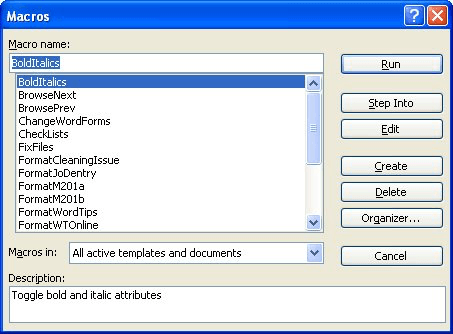Please Note: This article is written for users of the following Microsoft Word versions: 97, 2000, 2002, and 2003. If you are using a later version (Word 2007 or later), this tip may not work for you. For a version of this tip written specifically for later versions of Word, click here: Finding and Changing Word's Internal Commands.
Written by Allen Wyatt (last updated March 21, 2022)
This tip applies to Word 97, 2000, 2002, and 2003
When you are developing macros, you may want to replace one of the built-in commands used by Word with your own macro code. In order to do this, you must find out the name used by Word to refer to the built-in commands. You can do so by following these steps:

Figure 1. The Macros dialog box.
Now, if you want to change the command, continue on with the rest of these steps:
Note:
WordTips is your source for cost-effective Microsoft Word training. (Microsoft Word is the most popular word processing software in the world.) This tip (1509) applies to Microsoft Word 97, 2000, 2002, and 2003. You can find a version of this tip for the ribbon interface of Word (Word 2007 and later) here: Finding and Changing Word's Internal Commands.

Create Custom Apps with VBA! Discover how to extend the capabilities of Office 365 applications with VBA programming. Written in clear terms and understandable language, the book includes systematic tutorials and contains both intermediate and advanced content for experienced VB developers. Designed to be comprehensive, the book addresses not just one Office application, but the entire Office suite. Check out Mastering VBA for Microsoft Office 365 today!
Your macro, in the course of doing some processing, may create a directory that you later need to delete. Here's how to ...
Discover MoreWant a list of all the commands available in Word? You can get one easily by following these steps.
Discover MoreFor certain types of writing, you may want to make sure that the sentences in your document do not exceed a certain ...
Discover MoreFREE SERVICE: Get tips like this every week in WordTips, a free productivity newsletter. Enter your address and click "Subscribe."
There are currently no comments for this tip. (Be the first to leave your comment—just use the simple form above!)
Got a version of Word that uses the menu interface (Word 97, Word 2000, Word 2002, or Word 2003)? This site is for you! If you use a later version of Word, visit our WordTips site focusing on the ribbon interface.
Visit the WordTips channel on YouTube
FREE SERVICE: Get tips like this every week in WordTips, a free productivity newsletter. Enter your address and click "Subscribe."
Copyright © 2025 Sharon Parq Associates, Inc.
Comments